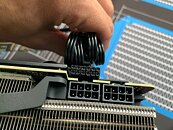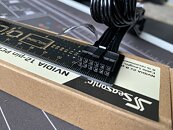- Joined
- Oct 9, 2007
- Messages
- 47,849 (7.39/day)
- Location
- Dublin, Ireland
| System Name | RBMK-1000 |
|---|---|
| Processor | AMD Ryzen 7 5700G |
| Motherboard | Gigabyte B550 AORUS Elite V2 |
| Cooling | DeepCool Gammax L240 V2 |
| Memory | 2x 16GB DDR4-3200 |
| Video Card(s) | Galax RTX 4070 Ti EX |
| Storage | Samsung 990 1TB |
| Display(s) | BenQ 1440p 60 Hz 27-inch |
| Case | Corsair Carbide 100R |
| Audio Device(s) | ASUS SupremeFX S1220A |
| Power Supply | Cooler Master MWE Gold 650W |
| Mouse | ASUS ROG Strix Impact |
| Keyboard | Gamdias Hermes E2 |
| Software | Windows 11 Pro |
Over the weekend, we got some of the first pictures of a production-grade NVIDIA 12-pin graphics card power connector that debuts with the company's GeForce "Ampere" Founders Edition graphics cards. HardwareLuxx.de received a set of modular cables by Seasonic that can be plugged into the company's modular PSUs, directly putting out a 12-pin connector. The publication's editor Andreas Schilling posted this striking picture that is sure to change our perspective about the 12-pin connector - it is tiny!
Called the Molex Micro-Fit 3.0 12-pin connector, the NVIDIA 12-pin connector looks visibly smaller than a single 8-pin PCIe power connector, and only slightly broader. It yet uses high gauge wires and pins, so it can push up to 600 W of power - more power than two 8-pin connectors. The space-saving connector shouldn't just be easier to plug in, but also cable-manage, since you're only having to wrestle with one cable, even for a high-end graphics card. Not only is the connector NVIDIA-exclusive, but there are also indications that only the Founders Edition (reference design) GeForce "Ampere" cards feature it, while custom-design cards based on the GPUs make do with a bunch of 8-pin PCIe power connectors.


View at TechPowerUp Main Site
Called the Molex Micro-Fit 3.0 12-pin connector, the NVIDIA 12-pin connector looks visibly smaller than a single 8-pin PCIe power connector, and only slightly broader. It yet uses high gauge wires and pins, so it can push up to 600 W of power - more power than two 8-pin connectors. The space-saving connector shouldn't just be easier to plug in, but also cable-manage, since you're only having to wrestle with one cable, even for a high-end graphics card. Not only is the connector NVIDIA-exclusive, but there are also indications that only the Founders Edition (reference design) GeForce "Ampere" cards feature it, while custom-design cards based on the GPUs make do with a bunch of 8-pin PCIe power connectors.


View at TechPowerUp Main Site




